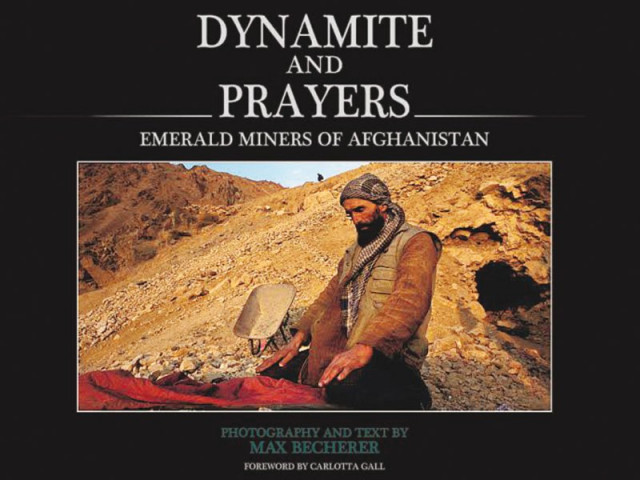Sharing a gold mine
Photojournalist Max Becherer set to launch book ‘Dynamite and Prayers’ at the Lahore Literary Festival.

The photo essay puts forth an up-close and personal story of people in the Panjshir Valley. PHOTO: MAX BECHERER
Capturing personal accounts of emerald-gem miners in Panjshir Valley in Afghanistan, award-winning photographer Max Becherer brings a collection of impassioned photographs of the lives of miners in his book Dynamite and Prayers, set to launch at the Lahore Literary Festival on Sunday.
Speaking to The Express Tribune, he said the story of the emerald miners was something he came across while he was posted in The New York Times Kabul bureau in 2007. “There were a range of stories from all over the country that we were covering. There was no new peg to this story and, eventually, the writer did not go with me. But I knew this was going to be a fantastic photographic story,” he said.

The photo essay compiled in the book puts forth an up-close and personal story of people in the valley, who continue to live their lives amid conflict. Having covered wars in Iraq and Afghanistan extensively, Becherer is known to have captured some of the most famous images of those living in the conflict-ridden countries.
The book looks at the facets of what makes up Afghanistan. The text of the book takes a retrospective glance at incidents that reshaped world politics. It speaks of events associated with the World Trade Centre, the fall of the Taliban and the death of Afghan leader Ahmad Shah Massoud, which was a part of the timeline series.
Returning to the Panjshir valley for this project, he started his journey of photographs from the village of Khenj, capturing the picturesque valley and its personal accounts. He photographed a child hanging upside down on an exploded barrel of a Russian tank in the Panjshir Valley of Shaba, what everyday life essentially is for the children and women in the valley. “The only photograph of a child playing on a tank was to capture the sense of innocence in what is a softer image of the valley,” he said.

Trekking for 7,000 feet, he was accompanied by donkeys and porters that carried food supplies and gas cylinders — weekly supply for miners. Hiking for almost half the day, he photographed haunting remains of Soviet presence in the region, with images of unexploded Russian bombs on the trail between the Panjshir Valley of Khenj. His final destination, the top of the mountain, looks deep into the lives of miners in their one-room stoned shelter, which is at the face of the Hindu Kush.
He covers the tale of seven to 10 men sharing a single home. Without proper gear, they inhale hazardous minerals while mining and planting dynamites. With 55 men catering to one mine, the elders share their experience of being fighters who battled against the Russians, while the younger generation of miners discusses their hopes of finding that one big rock, which could buy them a visa to Europe. He captures daily lives of miners through impactful images after they set off the dynamites.

“Time stands still inside there. They only know the clock has been ticking when the cook comes to call for food or prayer,” says Becherer. He then goes on to capture one of the most powerful pages of the book by photographing the game of Buzkashi. Through his lens, he takes shots of men playing the sport on horses.
Emerald, the second-most expensive gem in the world after diamond, comes from the valley. It goes from the Pinjshir Valley to Kabul, making its way to Peshawar and then Lahore, where the final product is sold to national and international markets, mainly the South Asia and Europe. The emeralds and the money have been tied to the tranquil Panjshir Valley and its fate. In the 1980s, people used the money from the sale of emeralds to arm themselves against the Russians who had invaded their country.
“Max Becherer sees and feels their spirit. He goes beyond the first impressions, the instant news, the first draft of history, and looks deeper into the souls of a people, and the heart of crisis before him,” says Carlotta Gall, a British journalist who covers Afghanistan and Pakistan for The New York Times and has also written the foreword for Becherer ‘s book.
Published in The Express Tribune, February 20th, 2015.
Like Life & Style on Facebook, follow @ETLifeandStyle on Twitter for the latest in fashion, gossip and entertainment.



















COMMENTS
Comments are moderated and generally will be posted if they are on-topic and not abusive.
For more information, please see our Comments FAQ